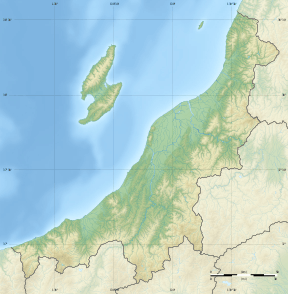Shimoyachi Site
| 下谷地遺跡 | |
 Shimoyachi Site  Shimoyachi Site (Japan) | |
| Location | Kashiwazaki, Niigata, Japan |
|---|---|
| Region | Hokuriku region |
| Coordinates | 37°23′51″N 138°37′27″E / 37.39750°N 138.62417°ECoordinates: 37°23′51″N 138°37′27″E / 37.39750°N 138.62417°E |
| Altitude | 80 m (262 ft) |
| Type | Settlement |
| History | |
| Founded | Yayoi |
| Site notes | |
| Ownership | National Historic Site |
| Public access | Yes |
Shimoyachi Site (下谷地遺跡 Shimoyachi Iseki) is an archaeological site containing the remnants of a middle Yayoi period settlement located in what is now part of the city of Kashiwazaki, Niigata in the Hokuriku region of Japan. The site was designated a National Historic Site of Japan in 1979.[1]
Overview
The site is located approximately 5 kilometers north-east of the city of Kashiwazaki, approximately at the center of a small marshy plain behind the dunes along the Sea of Japan coast. It contains the ruins of a village from in the middle of the Yayoi period (approximately 2000 years ago), which was excavated by the Niigata Prefectural Board of Education from 1977-1978. Six unique circular pit dwellings were discovered, which had a diameter of five to nine meters surrounding a central hearth. Each building was surrounded by a ditch 10 to 15 meters in diameter for drainage. Another rectangular structures were identified. In addition, the site had approximately 160 mounds in various shapes: circular, elliptical, and square arranged in two rows, which seem to have been used for various purposes. Some were grave tumuli containing the remains of wooden coffins, and others appeared to be used for storage. The village appeared to be a mass-production center for jadeite round and cylindrical beads, mortar balls and sling balls, and numerous items in the intermediate stages of production were also found. In addition, numerous examples of Yayoi period earthenware were found, including pots for storage and pots for cooking. The style was mostly with a combed design common throughout the Hokuriku region, but there were also a large number of pieces from Shinano Province, indicating long-distance trade.
Rice paddies were not discovered at the site, but a large amount of carbonized rice and stone sickles for harvesting rice were excavated, indicating that rice cultivation exist din the area.
The site is preserved "as is", with no reconstruction or public facilities.
See also
References
- ↑ "下谷地遺跡" [Chōjagahara Iseki] (in Japanese). Agency for Cultural Affairs.
External links
- Kashiwazaki City Tourist Information home page (in Japanese)